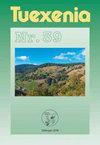Determination of habitat requirements of the glacial relict Nuphar pumila as basis for successful (re-)introductions
IF 1.1
4区 生物学
Q3 PLANT SCIENCES
引用次数: 1
Abstract
Nuphar pumila is a glacial relict, which is nowadays rare throughout Europe and red-listed in most European regions. In Switzerland only three autochthonous populations and one population of the hybrid with N. lutea (N. ×spenneriana) have survived to date, one of them in the canton of Zurich. To protect this species regionally, the canton of Zurich has commissioned the ex situ propagation of speci-mens, which then had been introduced to 37 water bodies in protected areas, including one known former site. Since only about 10% of these introductions had been successful, there was a wish to identify causes of this lack of success. To this end, we compared the vegetation and physical-chemical parameters of the four natural sites in Switzerland with the successful and unsuccessful introduction sites. Additionally, for a subset of sites, we assessed diatom genus composition as a proxy of water quality. Moreover, we derived vegetation plots of N. pumila and N. lutea from across Europe from the European Vegetation Archive (EVA) to compare their site conditions, using mean ecological indicator values and bioclimatic variables of the localities. We found that inside Switzerland the main differences were between the natural sites and all introduction sites, while successful and unsuccessful introduction sites hardly differed in the determined parameters. Natural sites had cooler water with lower magnesi-um content, and according to mean ecological indicator values, also lower nutrient status. The diatom data, though limited in amount, point into the same direction. The EVA data demonstrate that stands of N. pumila are mainly more oligotrophic, but also cooler and more acidic than those of N. lutea. We could not find any factor that explains the success vs. lack of success of plantations of N. pumila in multiple sites in the canton of Zurich, but our results rather indicate that due to the relatively warm climate, the high atmogenic nitrogen input and the predominantly base-rich bedrock, the sites in the canton are generally not particularly well suited for N. pumila. We consider it therefore more promising to protect and possibly (re-)introduce N. pumila in other cantons with higher elevation, base-poor bedrock and lower atmogenic nitrogen input.确定冰川遗迹浮石的栖息地需求,作为成功(重新)引入的基础
Nuphar pumila是一种冰川遗迹,如今在整个欧洲都很罕见,在大多数欧洲地区都被列为红色。在瑞士,迄今为止,只有三个本地种群和一个与N.lutea杂交的种群存活下来,其中一个在苏黎世州。为了在区域范围内保护该物种,苏黎世州委托物种迁地繁殖,然后将其引入保护区的37个水体,包括一个已知的旧址。由于这些介绍中只有大约10%是成功的,因此希望找出这种缺乏成功的原因。为此,我们将瑞士四个自然地点的植被和物理化学参数与成功和不成功的引种地点进行了比较。此外,对于一个子集的地点,我们评估了硅藻属的组成,作为水质的代表。此外,我们从欧洲植被档案(EVA)中获得了欧洲各地的N.pumila和N.lutea的植被图,以使用当地的平均生态指标值和生物气候变量来比较它们的现场条件。我们发现,在瑞士境内,自然地点和所有引入地点之间的主要差异,而成功和不成功的引入地点在确定的参数上几乎没有差异。天然场地的水较冷,镁含量较低,根据平均生态指标值,营养状况也较低。硅藻的数据虽然数量有限,但指向相同的方向。EVA数据表明,与木犀相比,浮萍林分主要更贫营养,但也更凉爽,酸性更强。我们找不到任何因素来解释在苏黎世州的多个地点种植N.pumila的成功与否,但我们的研究结果表明,由于相对温暖的气候、高的大气氮输入和主要富含碱的基岩,该州的地点通常不太适合种植N.pumilla。因此,我们认为在海拔较高、基岩较差、大气氮输入较低的其他州保护并可能(重新)引入N.pumila更有希望。
本文章由计算机程序翻译,如有差异,请以英文原文为准。
求助全文
约1分钟内获得全文
求助全文
来源期刊

Tuexenia
PLANT SCIENCES-
CiteScore
2.80
自引率
25.00%
发文量
0
期刊介绍:
Tuexenia publiziert Original- und Übersichtsarbeiten sowie Berichte zu Themen der Geobotanik / Vegetationsökologie und zu Nachbarwissenschaften wie Populationsökologie, Biodiversitätsforschung, Biozönologie, Renaturierungsökologie und ihren Anwendungen, vor allem im Naturschutz. Der geografische Schwerpunkt liegt in Zentraleuropa und angrenzenden Regionen.Tuexenia erscheint jährlich in einem Band, der etwa zur Jahresmitte fertig gestellt wird. Autoren erhalten von jeder Arbeit eine PDF-Datei und gemeinsam 20 Sonderdrucke kostenlos.
Die Qualität der wissenschaftlichen Manuskripte wird durch die Redaktion und einen Wissenschaftlichen Beirat (Peer Review) gesichert (s. auch die Manuskript-Richtlinien vor dieser Seite). Es werden keine Druckkosten erhoben. Tuexenia legt Wert auf allgemeine Online-Verfügbarkeit der Beiträge.
 求助内容:
求助内容: 应助结果提醒方式:
应助结果提醒方式:


